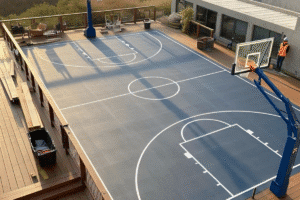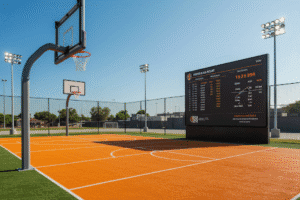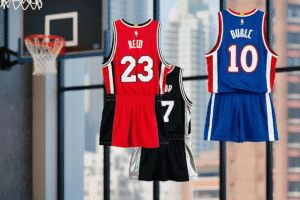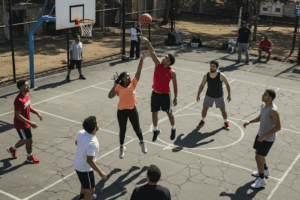Ever found yourself wondering why women’s basketball size look a bit different? Yep, the size of the basketball plays a crucial role, and I’m here to tell you why.
The difference might seem subtle, but it really impacts performance. Coaches and players alike agree that a well-sized ball can improve grip and precision, making every move count. So whether you’re a long-time fan or new to the sport, you may be feeling pulled to investigate this fun twist. It’s one of those behind-the-scenes tweaks that makes the sport even more engaging, so let’s dive in!
The Tale of Two Sizes (and a Little One Too!)
When we talk about basketball sizes, we’re mainly looking at a few key players:
- Size 7: The Big Shot:
- This is the standard for men’s basketball. Think NBA, college, high school—the whole shebang.
- It measures a hefty 29.5 inches in circumference and weighs a solid 22 ounces.
- “It feels like a touch heavier” as one of the transcribers said, and they are correct.
- It is also known as a size 29.5 basketball.
- Size 6: The Perfect Fit:
- This is the official size for women’s basketball, including the WNBA, college, and high school leagues.
- It’s a bit smaller, measuring 28.5 inches in circumference and weighing around 20 ounces.
- It is also known as a size 28.5 basketball.
- Size 5: The Little Legend:
- This one’s for the young’uns, typically those eight and under.
- It measures 27.5 to 27.75 inches and weighs 14 to 16 ounces.
- Getting a ball to a 10-foot hoop is hard enough; this ball helps make it a little easier.
Why the Size Difference? It’s All About the Hands!
Now, you may be thinking, “Why the different sizes?” Well, it boils down to hand span. Women generally have smaller hand spans than men, and a size 6 ball is simply more manageable.
- Better Control: The smaller ball allows for better control during shooting, passing, and dribbling.
- Enhanced Gameplay: It’s all about enhancing the gameplay experience, making it more comfortable and efficient.
Why Hand Size Matters: The Science Behind the Ball
Ever wonder why the WNBA’s smaller basketball just feels right? Science backs this up. In a study, researchers tested 70 adults to see how hand size affects grip strength, and here’s the kicker: women’s hands work best with equipment tailored to their size.
When participants squeezed grip-measuring devices set at different widths, women consistently performed strongest when the grip matched their hand size. For men? It didn’t matter as much—they could max out their grip at a fixed width. But for women, the sweet spot wasn’t one-size-fits-all. The study even came up with a handy rule: For women, the ideal grip width is roughly 1/5th of their hand length plus 1.5 cm.
What this means for basketball: Smaller hands = better control with smaller balls. That’s why legends like Sue Bird pushed for FIBA to adopt size 6 balls internationally. It’s not just tradition—it’s physiology! Women’s hands literally grip and control a smaller ball more effectively, which is why leagues like the WNBA prioritize the 28.5” ball.
Here is a link to the study’s abstract if you want to learn more.

A Bit of History (and Some Fun Facts)
This isn’t a new concept. The NCAA adopted the size 6 ball for women’s basketball back in 1985, and FIBA followed suit in the 2004-2005 season. It’s a change that’s been in place for quite some time, and for good reason!
- “Six months ago I found out that there’s such a thing as, um, girl’s balls and they got the size six,” one of the people in the transcript said. So it is not uncommon for people to not know about the size difference.
Here’s a fun twist: Not all leagues play by the same size rules! While the WNBA uses the trusty 28.5-inch ball, FIBA (the group that runs international basketball) has its own little quirk. For women’s games outside the U.S., FIBA balls are slightly bigger—29 inches around. Yep, just a half-inch difference! It’s like ordering a “medium” drink and getting a cup that’s almost the same… but not quite. This tiny gap means players switching between leagues have to adjust their grip and shooting touch, almost like retuning a guitar string.
And here’s the kicker: FIBA’s rules for testing ball bounce are super specific. They drop the ball from 6 feet up and want it to bounce back between 4 and 4.5 feet. No guesswork allowed! Meanwhile, the NBA and WNBA keep it simpler—they care more about the ball’s weight (22oz for men, 20oz for women) than the exact bounce height.
| League | Ball Size | Weight | Inflation PSI |
|---|---|---|---|
| WNBA | 28.5” | 20 oz | 7.5–8.5 |
| FIBA | 29” | 20.5 oz | 7.0–8.5 |
| NCAA | 28.5” | 20 oz | No requirement |
FIBA vs. NBA: A Sneaky Size Twist
Here’s a fun nugget: not all pro leagues use the same sizes! While the WNBA sticks with the trusty 28.5-inch ball, FIBA (the folks who run international hoops) use a slightly bigger ball for women—29 inches! It’s barely noticeable, but it shows how even small tweaks can shape the game.
Men’s basketball has its own quirks too. FIBA’s men’s ball is a hair bigger than the NBA’s (30.7 inches vs. 29.5). But here’s the kicker: both leagues agree on one thing—weight matters more than size. A heavier ball (like the NBA’s 22-ounce beast) sinks into the rim smoother, while lighter balls (hello, size 6!) bounce around like hyperactive bunnies.
Adjusting to the Size 6: It’s Easier Than You Think!
If you’re used to playing with a size 7 ball, switching to a size 6 might seem daunting. But believe me, it’s not as hard as you think.
Quick Adaptation: Players can typically adapt to the size 6 ball within a few practices. Let’s see what people had to say about this change:
- “My first day with the size six balls, you’re going to have to make an adjustment” one stated.
- “I want to adjust for the extra light weight yeah, stop fighting most of my shots are going too far I’m trying to adjust and now they’re like too short.” This is a great example of the adjustment period.
- “You can get the size 6 to go further.” This also is a common theme from the transcribers.
Beyond Size: Other Important Factors
While size is crucial, there are other factors to consider when choosing a basketball.
- Material and Construction: Indoor and outdoor balls have different constructions to handle various playing surfaces and weather conditions.
- Inflation: A properly inflated ball should bounce close to your elbow height. “If you’re like me, you like it; it’s a little easier to dribble, and it gives you a better bounce off the rim,” as one of the speakers said.
- Weight: The weight of the ball also plays a factor. “The six is very, very light,” one of the transcribers stated. Also, “the seven obviously is heavier, but I find it goes in the bucket a little bit easier. You shoot it, it hits the rim, and like the weight of it actually falls in.” This is one more example of the difference between balls.
The Lightness Factor: Why Air Matters More Than You Think
Ever wondered why your buddy’s backyard ball feels like a rock? It’s all about the air! Pumping extra air into a basketball doesn’t just make it bouncier—it can actually trick you into thinking it’s lighter. But here’s the catch: Overinflating stretches the ball’s skin, making it stiffer and way harder to control. Players in the transcripts nailed it: “The six is so light, it bounces weird off the rim” vs. “the seven’s weight helps it drop in.”
Pro tip: If your shots keep rattling out, check your ball’s air. A properly inflated ball should bounce up to your elbow when dropped from your chest. Too much air? You’ll fight the bounce. Too little? It’ll feel like dribbling a sack of flour.
Bounce Matters: The PSI Sweet Spot
Ever notice how a slightly flat ball feels like it’s dragging? That’s where inflation comes in! Just like Goldilocks, you don’t want your ball too hard or too soft—it needs to be just right. The NBA and WNBA keep their balls pumped between 7.5 and 8.5 PSI (that’s pounds of air pressure, by the way).
Why does this matter? Think of it like tuning a guitar. A properly inflated ball bounces predictably, whether you’re dribbling down the court or banking a shot off the rim. As one player in the transcripts said, “I like it a little easier to dribble when it’s pumped right—gives you a better bounce.” Too much air? The ball becomes a rock. Too little? It’s like dribbling a sack of potatoes.
The Lightness Factor: A Bouncy Surprise!
One of the most interesting things I found in the transcripts was the discussion about the lightness of the size 6 ball.
- Extra Bounce: Because it’s lighter, the size 6 ball tends to bounce more off the rim.
- Accuracy Matters: This means you’ll need to be more accurate with your shots.
- “It feels so light though, but the difference is because this is lighter it actually bounces in the rim even though it’s smaller. You think, oh, you have more room in the rim, but it actually is bouncy.” This is a great explanation of the bounce.
Dribbling with the Size 6: A Slippery Situation?
Dribbling with the size 6 ball can take some getting used to as well.
Slippery Fingers: Some players find that the smaller ball slips off their fingers more easily. You’ll often hear someone say things like, “I find dribbling with the six difficult because it’s so small it always slips off a finger”.
Final Thoughts: Embracing the Size 6
So, there you have it! Women’s basketball size can be smaller and rather usefully so since it’s all about providing a better gameplay experience. Whether you’re a seasoned pro or just starting out, embracing the size 6 ball is key.







